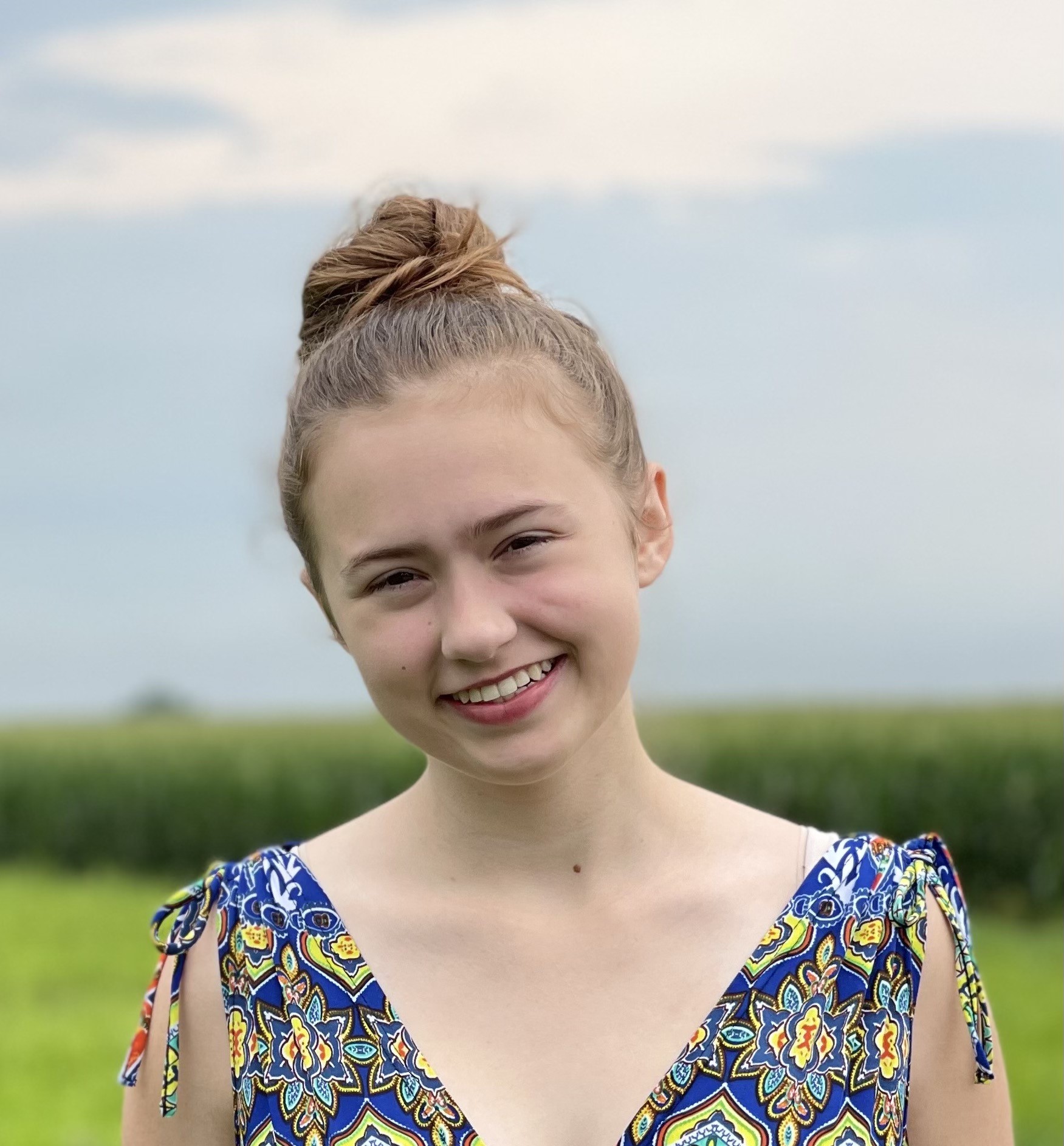The Grinnell Jewel Box Quilt Guild, located in Grinnell, IA, is a community organization of local quilters and is open to anyone to join. The Guild holds monthly meetings at Drake Community Library, and a yearly retreat, where members come together at a larger venue to work on their projects together. This piece tells the story of my introduction and participation in these gatherings, as a new member, and the beautiful, surprising, and intricate community I found there.
Bernina? Brother? Babylock?
I sat in the plastic chairs of the community room in Drake Community Library, waiting for my first quilt guild meeting to begin. I was a complete stranger to all the women surrounding me, who were quizzing me, rapid fire, about my name, my projects, my home, and my interest in sewing, and I answered as fast as I could. Someone asked what brand of sewing machine I use. “Yeah, I think mine is a Babylock,” I responded. The buzz of conversation eventually wandered elsewhere, and I listened as everyone filed into the room, checking on their neighbors and asking the whereabouts of absent members. The room was energetic and warm; jokes and projects and stories were passed from person to person.
Given their friendliness, frank interest in me, and passion for sewing, I shouldn’t have been surprised when, over the next months, the members of the quilt guild generously shared their stories and scraps of fabric with me, inviting me to learn the histories of their projects and their lives. With open arms, they invited me to the quilting retreat, a sort of sewing paradise, where members each claim a table for their quilt in progress, working, laughing, and joking together. It was through these meetings and the retreat that I began to really get to know the guild.
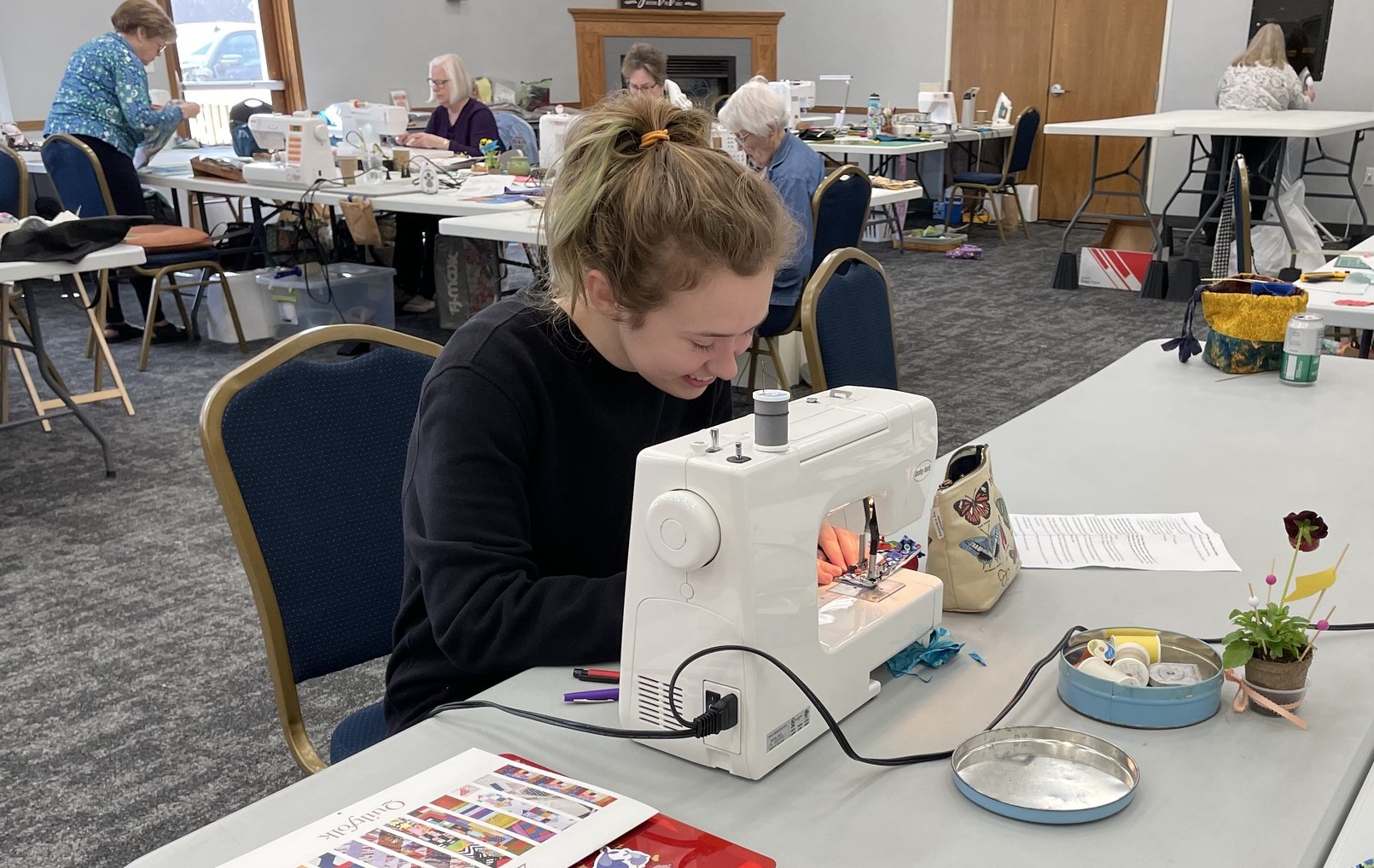
Quilting at the retreat. Photo by Karen Cochran.
“We all just know each other”
“Eager and wide-eyed” is how some guild members described themselves upon their first joining the guild. Many of the current members were blown away by the talent and skills of other members. Even at my first meeting, the respect each member had for the other was clear. Some had been designing and making quilts for decades, publishing articles in quilting books and magazines. Others were making quilts based on patterns these members had published — all they had to do was walk across the room and ask the designers’ opinion if they wanted it.
So of course, attending the first day of the quilting retreat, with only a fraction of the sewing experience they had; I certainly felt eager and wide-eyed. Yet, even when I made mistakes – when I didn’t make crisp corners or when I had to rip apart my seams — they just said “no one will notice,” with a gentle smile that encouraged me to keep working.
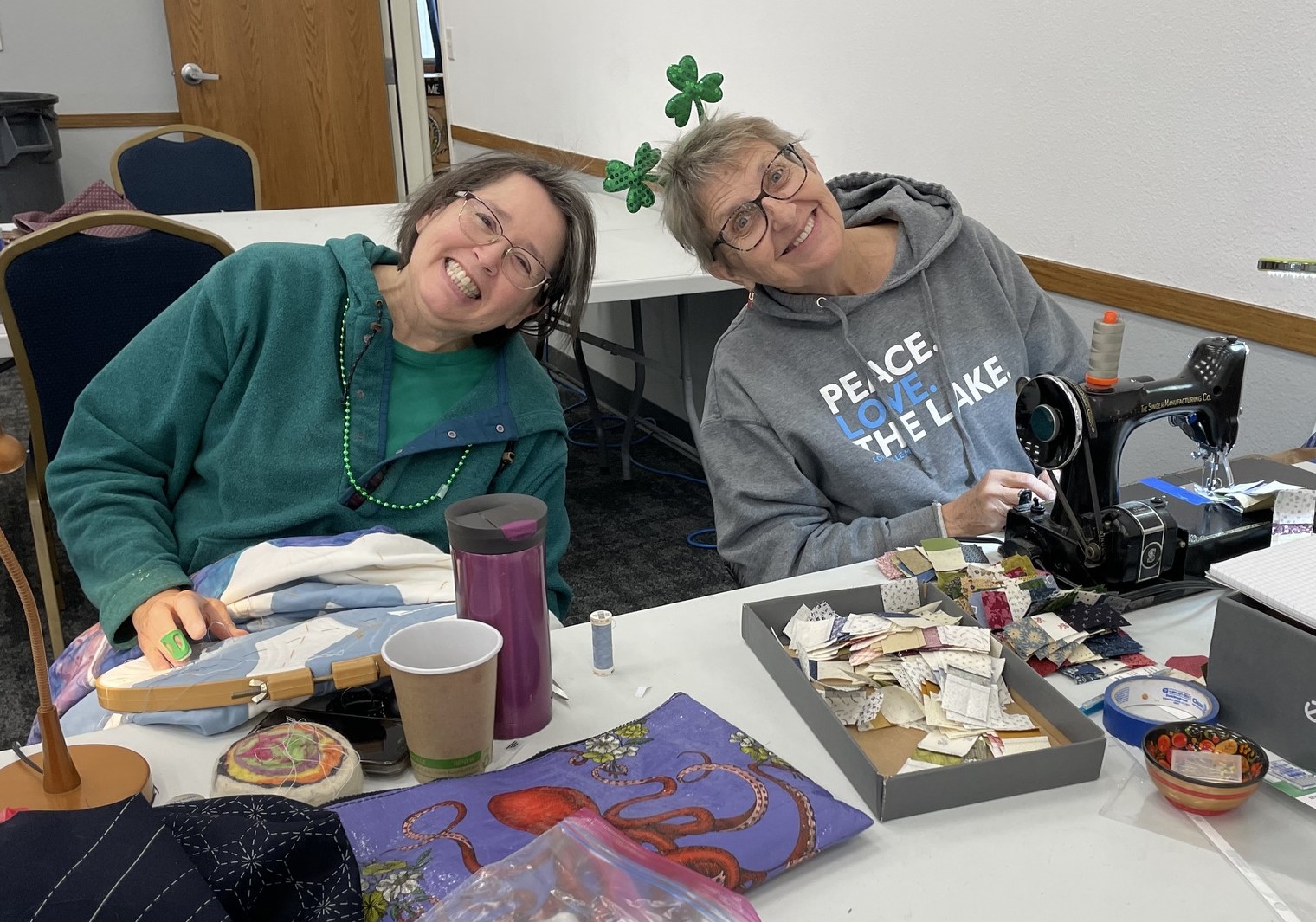
Quilt guild members enjoying themselves at the retreat. Photo by Karen Cochran.
Growing up, I used to sing a hymn at church with the lyrics “guard each one’s dignity and save each one’s pride.” 1 Regardless of the religious connotations of this line, I feel like it applies in a more general way to how communities care for their members—especially within this group. Humans are so socially messy; to me, what makes a community is radical acceptance of people’s talents and flaws. Many guild members expressed strong feelings of acceptance in the Grinnell guild, where participants did not try to ‘one-up’ each other, comparing this experience favorably to social dynamics they experienced in other groups. “We all just know each other,” was the way it was explained to me when I asked about the community. “Grinnell just fits.” And this knowing is deeper than just being familiar with faces and names; it is a knowledge of each person’s habits and needs so the group can—as the hymn suggests—protect the dignity of each member. This means acknowledging anyone who has an announcement during sharing time, knowing who prefers hand work to quilt work, or who has extra time to help with quilt math, or who needs to be checked in with during hard times.
From the major topics to the minor details, each member learns about the guild’s other members—everything from their favorite styles, their families, and the famous snacks they make (such as Dorothy’s almond tart). In the words of one member, “that’s the kind of people we are.” In the words of another, “I love you.”
Quilting Through Loss
I made my first quilt at age 9. I remember so clearly cutting pieces out of curtain samples and organizing the arrays of color into a nine-patch lap quilt. I selected the backing and the binding (a splotchy rainbow pattern that didn’t totally match the rest of the quilt), sewing on the last of the binding in my grandmother’s guest bedroom in a loose child’s stitch. Later, I remember visiting her in the hospital, where that quilt was spread over the end of her bed, as she described to me how feeding tubes worked. When I look at that quilt, which became mine when she passed, I am reminded of how I was able to capture some of that emotion in the quilting, even at such a young age. I hope the effort and care I put into designing it for a person I loved so dearly was evident to my grandmother.
Quilting can convey care and bring beauty. One member of the guild shared leftover fabric with me from a shirt that she handmade for her late husband. She told me how much care she put into the making of the shirt: first dying the bamboo cotton and then assembling the pieces. Her husband was buried in this shirt, a garment made with such care.
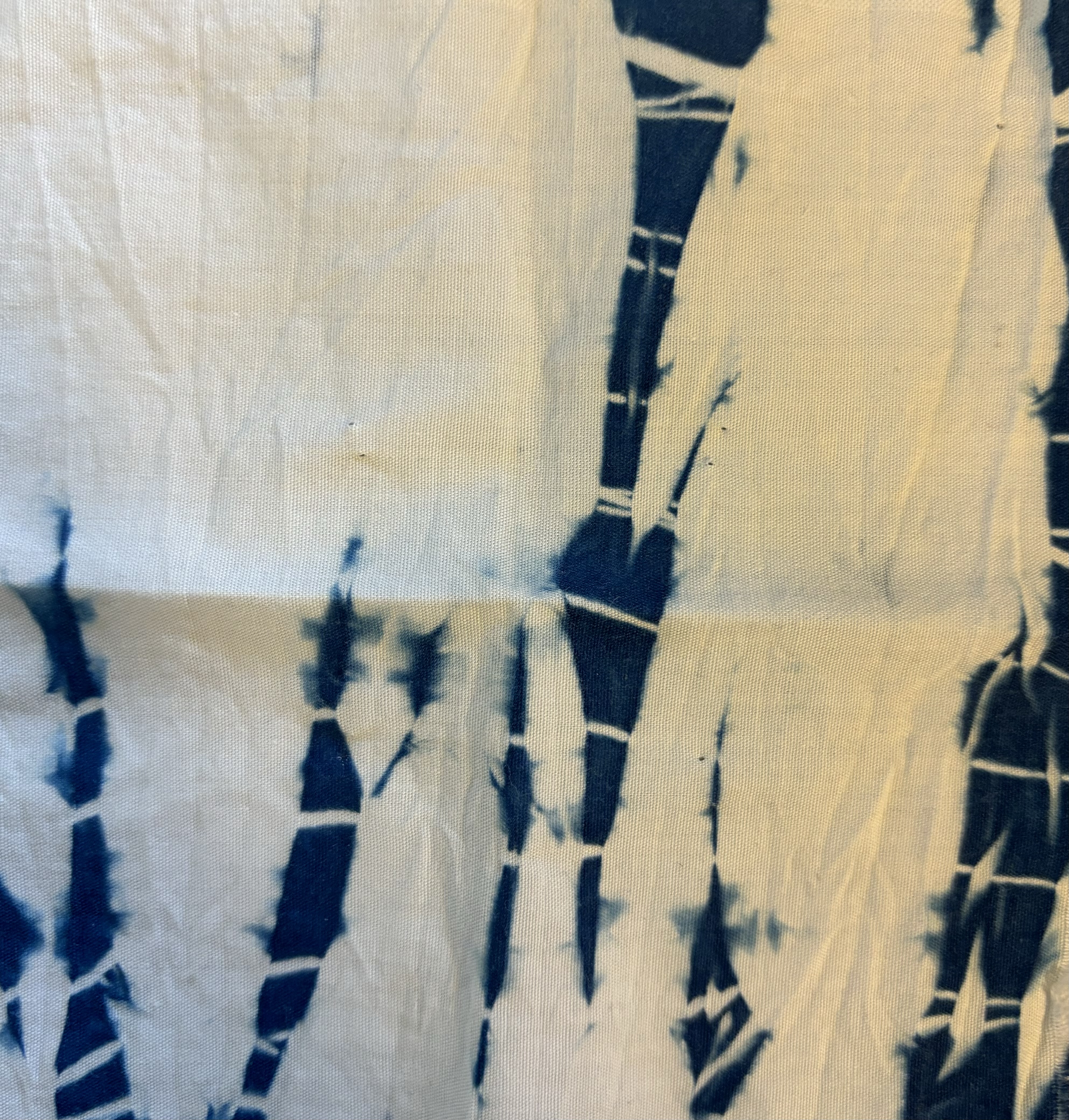
The hand dyed bamboo cotton. Photo by Sophia Unzicker.
Quilting can be an avenue for healing and an expression of pain. A late member of the quilt guild brought her child, sister, and mother to the guild to learn to quilt with her after learning of her cancer diagnosis. She made many quilts for donation to benefits and she made quilts for family as well. After she passed away, the quilt guild became a space of support and bonding for her family. Her impact on the guild was clear to me through the way members talked about her and the way her family continues to quilt, honoring her memory after her passing.
Both individual and community pain can be processed through quilting. One member recounted to me, how at the 2020 quilt guild retreat, she brought a project that was nine years old. It was a pattern that required lots of hand work, cutting, and piecing the individual blocks – and she had finally finished enough blocks to assemble the quilt top. At the guild, “everyone agreed that it looked like the COVID-19 virus.” In the coming week, the entire world began to shut down. Over the pandemic, reliance on fabric products increased – masks became a necessary and life-saving product. Many home seamstresses began making masks, me included. We donated some, kept some, and made some for friends and family members. Sewing was a reliable and doable quarantine activity. It helped me pass those long days. Years later, as the world began to repair itself, sewing again played an important role in healing. One guild member worked at Grinnell College’s Burling Library. She was the first worker to come back to the library because she worked in circulation. It was lonely work. She had to put books that students requested out in plastic wrap. She decided to make little pencil-pouch-type cases from dark blue fabric with squirrels on it to spread joy to the students as they picked up their books.
While quilts and pencil pouches might not be the first things that come to mind when one is thinking about healing, these soft, tangible items are emotionally important to healing the parts of our bodies that cannot be mended with bandages and antibiotics.
Family Ties
Something about stitching hits close to home – maybe that’s because quilting knowledge has been passed down through family tradition; maybe that’s because the art we make feels like family, or maybe it’s because the effort put into a quilt requires careful consideration of its recipient.
Regardless, the network of quilters stretching out from the Jewel Box Quilt Guild contains many siblings, parents, children, and spouses. Guild members shared their participation in sister quilting group chats — “active text chain[s] … of our current projects.” Many members shared stories of quilts given to children and grandchildren. Even at the guild meetings and retreat, most of the quilts in progress were intended for others — some were donation quilts, in bright fabrics and children’s patterns, another was a beautifully detailed traditional Hawaiian quilt, with hand stitched dolphins emerging from the waves, intended for a child who requested it years before.
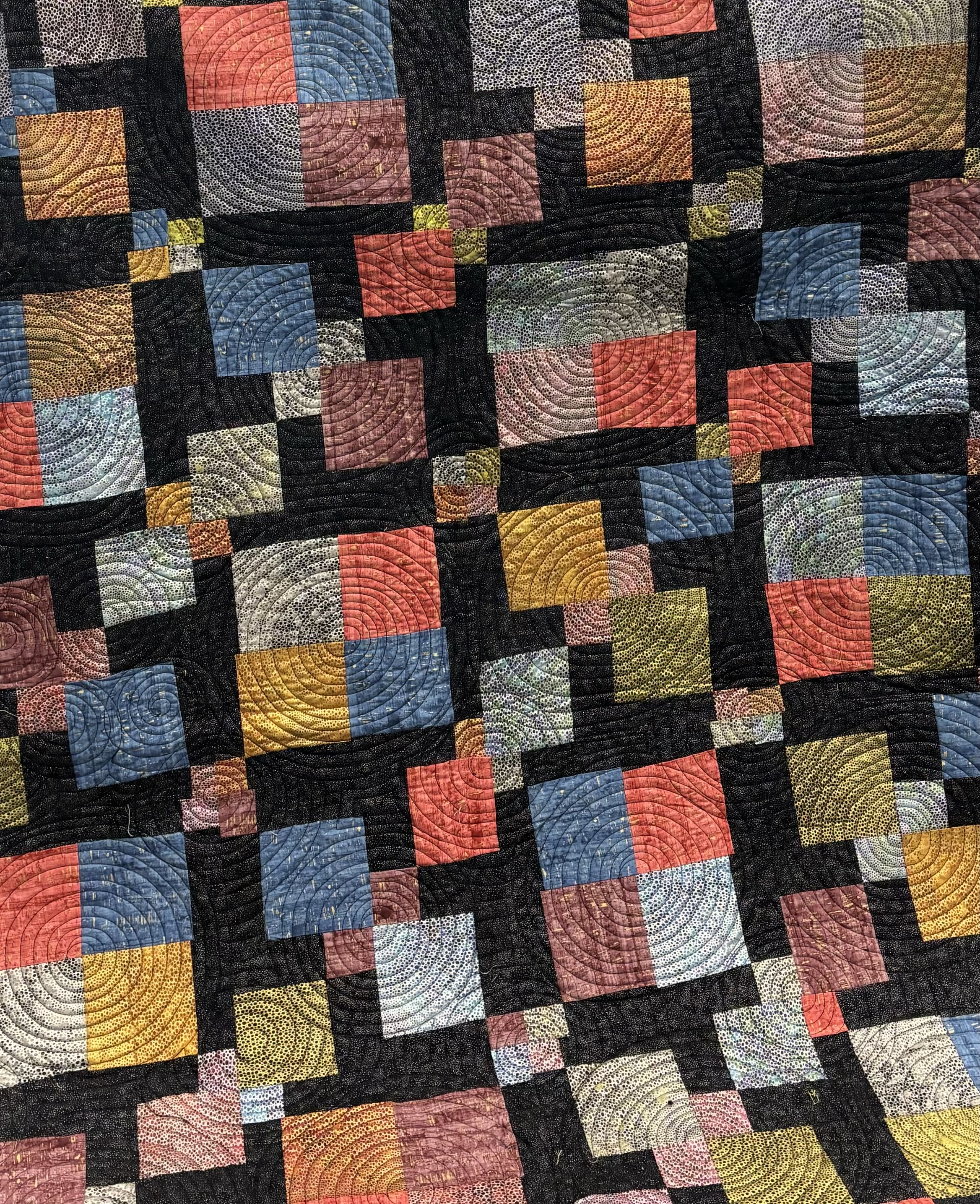
A dissapearing nine patch quilt made by the guild’s youngest member. Photo by Sophia Unzicker.
At the retreat, others shared their sadness at the lack of appreciation family members had for the beautiful pieces they had inherited from their families and they reflected on where these gorgeous quilts they loved so much might end up after their passing. In general, there is an undercurrent of disappointment at the eroding recognition of quilting as a skill and art as commercialization of textiles lowers peoples’ understanding of the effort and time necessary to quilt. Despite this trend, it is clear to me that the next generations are still captivated by the skill of quilting. The youngest member of the guild began quilting when he was less than 10 years old. I am one of two college students who currently attend the guild, but when I mention it to other students, they ask about meeting times and required skills, with eagerness in their voices.
The persistent interest in quilting is clear, manifesting itself through three generations of quilters who attend the guild together, and in the community surrounding the guild, expanding the meaning of family to all those participating.
Calista from Toledo could “stop the sun from rising.”
That’s what one member told me about her Great Aunt. After all, she made a living as a seamstress, unmarried — during a time when supporting oneself as a single woman was not as socially acceptable. It’s no surprise to me that she was independent and determined enough to stop the world from turning.
Some members learned to sew from their mothers, who quilted out of necessity instead of for enjoyment. As with Calista, sewing was a task these people learned because it was a way to support themselves or their family. Learning on feed sack cloth and fabric scraps, some women used their sewing skills to make clothing for themselves and their families. My grandmother tells me about the outfits she made for my mother and aunts, and how growing up, her clothes were all hand-sewn by her grandmother.
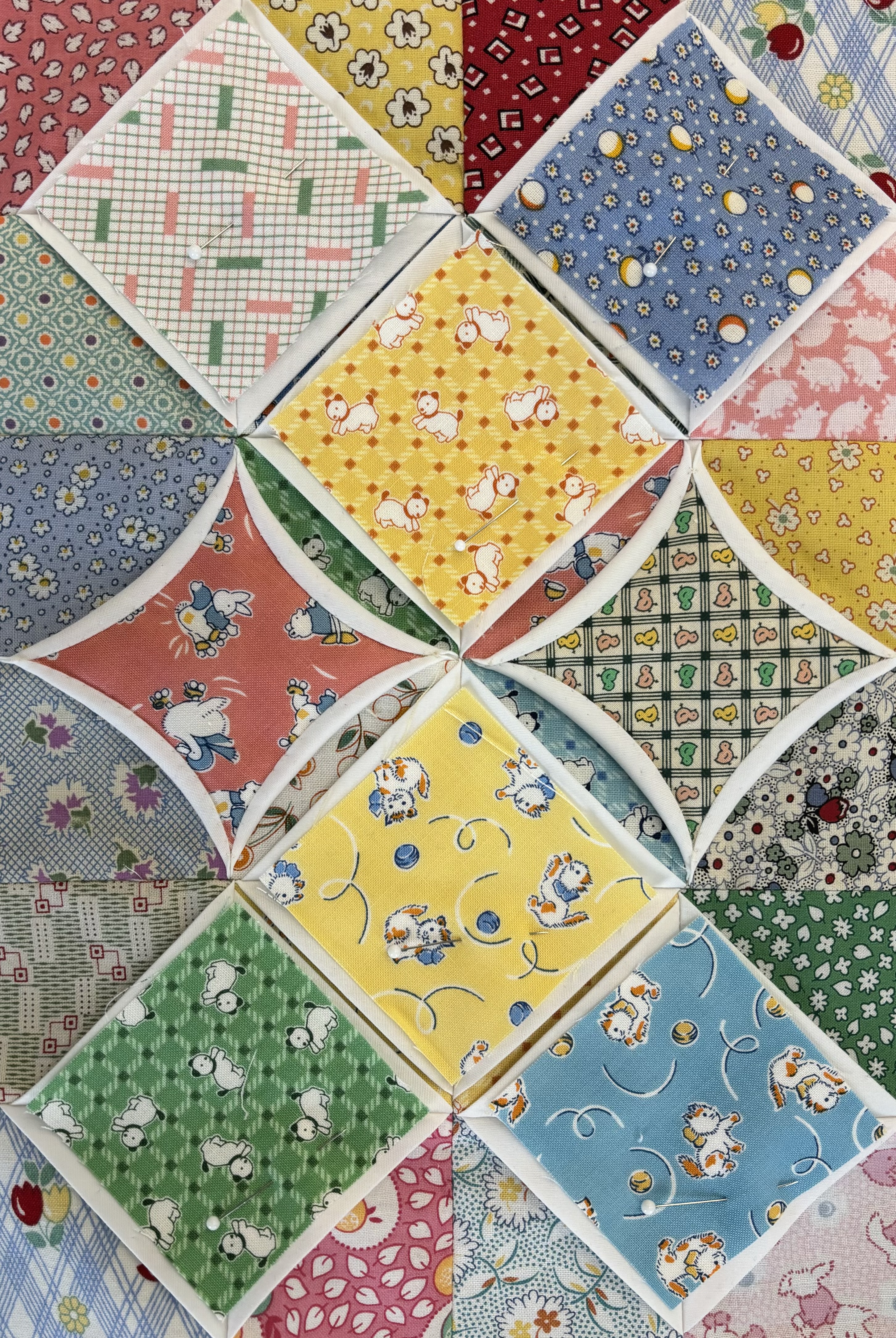
A guild member’s Cathedral Window pattern work. Photo by Sophia Unzicker.
And while some of the members have been sewing since childhood, quilting is a new skill for others, passed down through all sorts of venues, from classes, from friendships, and through family ties. Though they are cultivated in a variety of ways, the knowledge and traditions of quilting reflect the tension between quilting as an assigned skill and quilting as a talent and hobby. Throughout history, women have transformed an assigned skill, seen as their responsibility as a woman, into a talent, an art, a science, and for those like Calista, a living. The untrained eye might not note the detailed geometric calculations necessary for piecing, the color-planning and coordination the quilts require, or the beauty in scraps transformed into something useful for a loved one. In the quilt guild, however, these talents are celebrated; there is a recognition of the effort and knowledge necessary to produce such beautiful works of material art.
And recognition of these talents is too often missing, because of the way quilting has been seen as “women’s work.” Further, the intersectional effects of racism and sexism have erased from history the artistry and quilting knowledge of black women. As bell hooks writes “in contemporary capitalist society, where ‘folk art’ is an expensive commodity in the marketplace, many art historians, curators, and collectors still assume that the folk who created this work did not fully understand and appreciate its ‘aesthetic value.’ Yet the oral testimony of black women quiltmakers … so rarely documented … indicates keen awareness of aesthetic dimensions”.
There is so much more recognition due to quilters and their work, especially black women whose work has been dismissed. 2
Gambling, Dangerous Women, and Diapers
“It’s time to teach the college girls how to gamble!” That statement caught me off guard, but soon dimes were gently pressed into my hands, and being ushered towards the big round dining tables to play Left, Right, Center. The youngest of the guild was selected to introduce the game, a highlight of his weekend. As we learned the rules, chairs were continuously pulled up, until our knees could all barely fit under the table. Competitive and encouraging, we laughed and complained as most everyone lost. The youngest member won, cheering and celebrating with everyone else. A few ladies burst into a rendition of the song “We are the Champions.”
Honestly, a quilt guild was not someplace I would have expected to learn to gamble; but this guild doesn’t fit all the stereotypes expected of older women. The guild is an open, welcoming place, but that doesn’t mean there is no room for inside jokes. The women are aware of the expectations surrounding age and their hobbies and turn these perceptions into comments about sewing diapers for themselves and referring to their friends as “dangerous” women. Even their supplies are inside jokes; I was lucky enough to be introduced to Richard, a shirtless (and pants less) man on their ironing board cover. I love watching the Guild make room for rowdiness and teasing to occur in the same setting as care and acceptance.
A Quilt Full of Stories
In the months that I got to know the Grinnel Jewel Box Quilt Guild, I began to design and assemble a quilt that reflects and incorporates their stories. It will contain fabric from more than 25 people’s collections, which they kindly provided for my project. Each of these fabrics has a story. Some of them are contained in the above essay. Others were written on little pieces of note paper and shared with me. Still others were mailed to me or handed to me with descriptions of the projects they were left over from: projects made for grandchildren, strangers, sisters, couples, and so many more people. Some are from my family: scraps given to me by my mother for use in this project. Some are historical: the Amana calico is over 125 years old, made in the Amana Print Works factory and dyed their classic deep blue. Some are mysterious: a few of the pieces came from a scrap bag in the thrift store, with the stitches of strangers incorporated into my own.
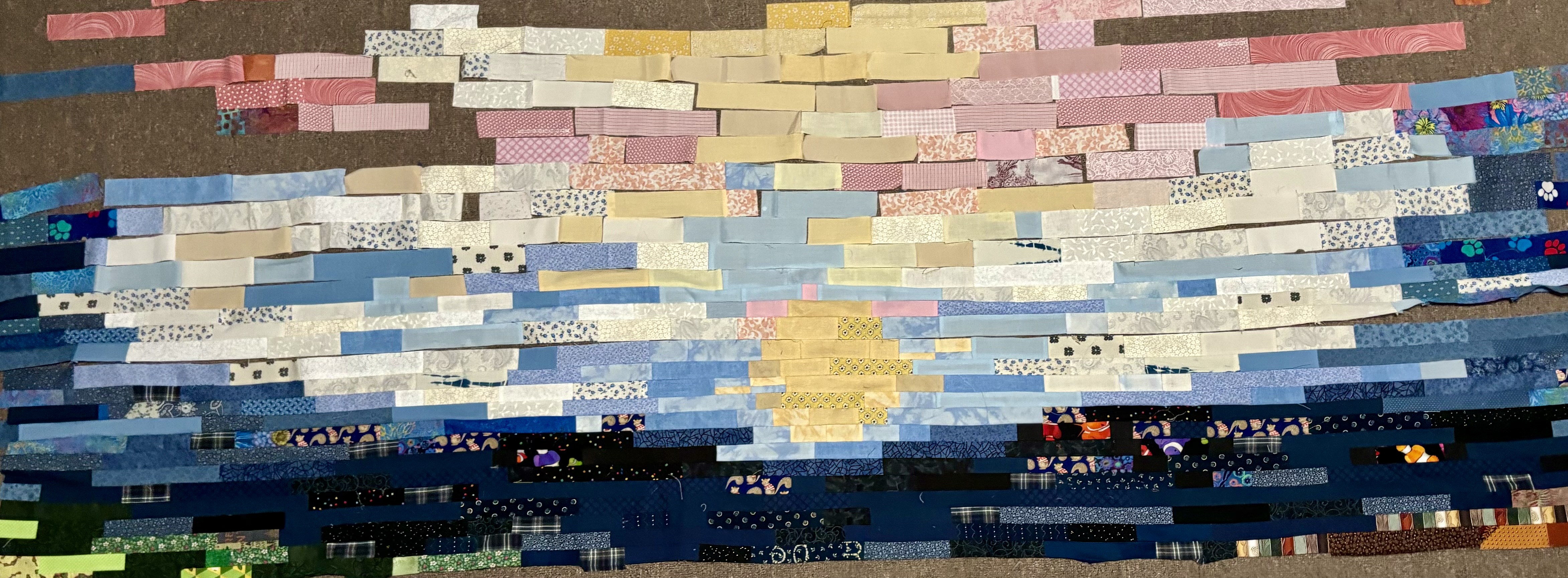
The top half of the quilt, assembled with 1.5 inch fabric strips. Photo by Sophia Unzicker.
When the quilt is finished, photos will be run in the online edition of Rootstalk, under this article title. Following is a photo of the quilt in progress—designed with bright Iowa sunsets in mind. When looking at this image, I hope you see all the stories that take place here, in the middle of Iowa’s prairie region, full of pain, healing, happiness, hope, family, friendship, community, and love.
1 Scholtes, P. (1966) ‘They’ll Know We are Christians.’ in Voices Together (387). Harrisonburg, Virginia: Menno Media.
2 Hooks, bell. (2008). Aesthetic Inheritances: History Worked by Hand. In (pp. 153–161). essay, Routledge. Retrieved May 20, 2024, from https://doi-org.grinnell.idm.oclc.org/10.4324/9780203888018.


